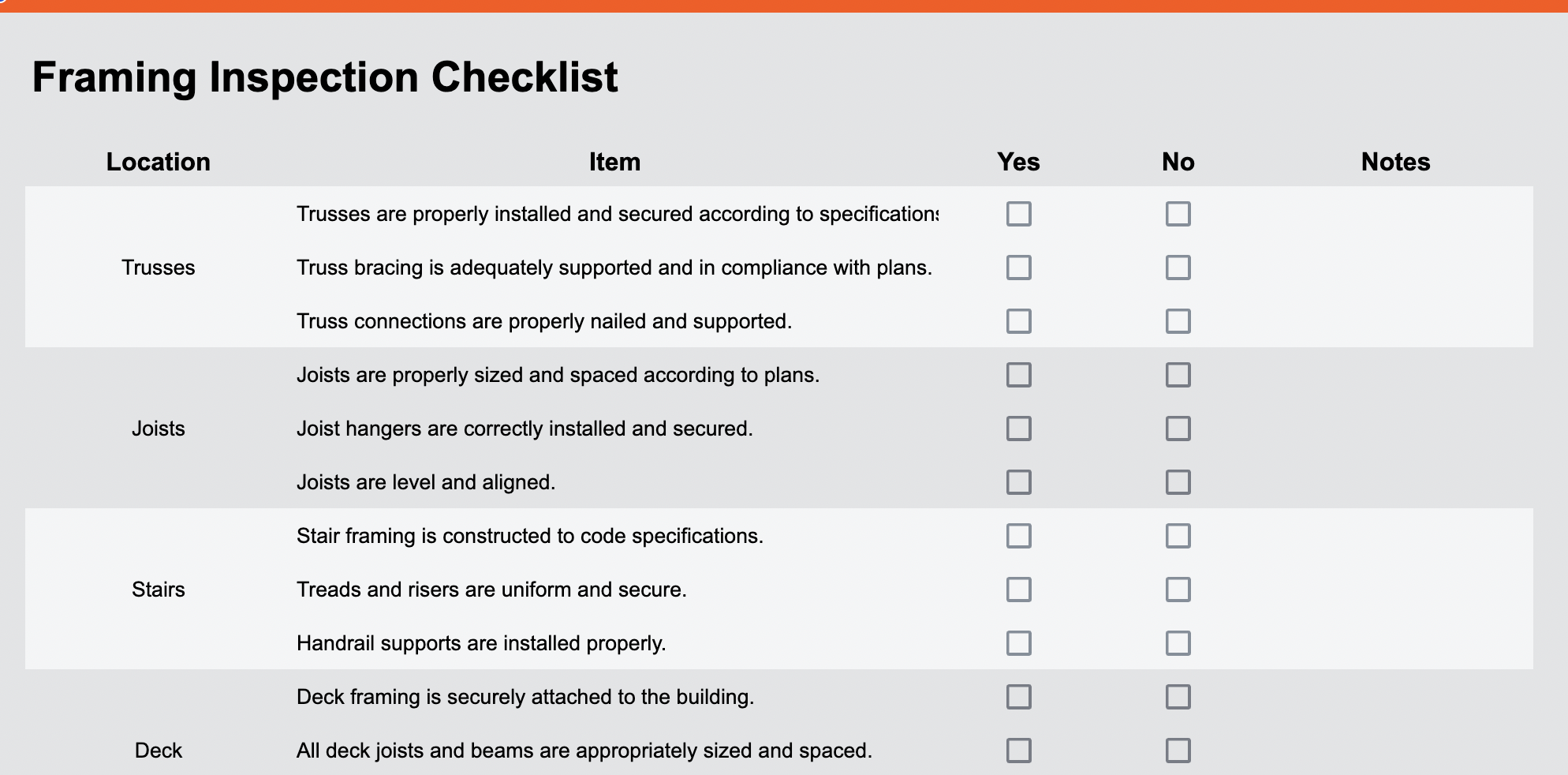— 4 min read
Construction Framing Inspection Checklists for Safety and Compliance (With Free Template)

Last Updated Nov 13, 2025

Kristen Frisa
Contributing Writer
111 articles
Kristen Frisa is a contributing writer for Procore. She also contributes to a variety of industry publications as a freelance writer focused on finance and construction technology. Kristen holds a Bachelor of Arts in Philosophy and History from Western University, with a post-graduate certificate in journalism from Sheridan College. She lives in Ontario, Canada.

Ben Ashburn
Staff Trainer & Program Manager
22 articles
Ben Ashburn is a Senior Construction Education Trainer at Procore. After a successful career as a construction estimator — working his way up from estimating manager to senior estimator — Ben has spent the most recent part of his career in construction sharing his skills with other as a construction educator. Ben has an extensive background in construction education: He has been an assistant professor in the Department of Construction Science at Texas A&M, and lectured about estimating, scheduling, management, and other related construction topics at Murray State University. He has been a construction training and learning development partner with Procore since 2019.
Last Updated Nov 13, 2025

Construction uses all kinds of inspections to make sure projects are going to plan. Framing inspections are no different: They judge a building’s frame and components to ensure everything is installed correctly and according to local codes.
Inspections are a good tool: They help with the quality control of a new structure. Still, contractors may get a little worried ahead of their inspections, because failing one can be expensive and cause project delays.
To best prepare for framing inspections, contractors can use a framing inspection checklist to go through all the elements of their project as it progresses, ensuring everything goes smoothly and the project is set up to pass.
This article will discuss items that might be included on construction framing inspection checklists and how contracting teams can use them for optimal project performance.
Table of contents
What is a framing inspection checklist?
A framing inspection checklist is a list of requirements that guides professional inspectors, construction managers, supervisors and contractors to evaluate the integrity and accuracy of a building's frame during construction. It ensures that all components meet specific standards and codes.
The integrity of newly constructed buildings depends partly on the quality of their framing. Conducting framing inspections early in the construction process can help identify issues before they become more costly or hazardous.
While inspectors use a checklist to complete required inspections, builders and contractors can use them to better prepare for coming inspections by frequently checking a project to make sure the framing is up to code and correcting any problems along the way.
Free Download
Framing Inspection Checklist
Use this framing inspection checklist to create a personalized list of inspection items. It includes suggested elements inspectors have an eye out for and room for notes.
- Free starter template
- Ready-to-use with room for customization
- Trusted by construction professionals


Key Components of a Framing Inspection Checklist
A checklist that covers framing quality seeks to ensure the framing is of good quality and follows local building codes laws. Here are some of the key areas it might cover:
Building Plans and Layouts
Checks the dimensions as built to ensure they align with the approved building plans
Trusses and Joists
Ensures beams and hangers for trusses and joists are installed correctly
Connections and Fasteners
Confirms connections and fasteners are secure and appropriate for the load they carry
Compliance with Building Codes
Elements like fire blocking and shear walls that adequately transfer forces to the foundation have to be worked into the built structure to maintain its safety and integrity.
Common Issues Identified During Framing Inspections
During inspections, there are some common issues that may cause framing inspection failures. Addressing these issues promptly can help build a strong building and pass framing inspections.
Misalignment of Structural Elements
The strength of a structure depends in part on the way the load of the building is distributed through the frame. If the pieces aren’t lined up correctly it may weaken the structure. For instance, a beam or girder bearing must have a column beneath it at least the same width as the beam in order to transfer the load through the wall to the footing.
Compromised Studs
Boring too big a hole in a stud can compromise the strength of a wall. If, for instance, a bathroom requires a ventilation pipe 3” in diameter, the hole that must be bored to make way through a stud can be overly large. The stud may have to be reinforced with metal plates or other studs alongside it.
Incorrect or Insufficient Fasteners
Although it’s a key aspect of framing, lack of sufficient fasteners is an easy miss and may be a key reason for failing inspections. For instance, houses built on slabs must have concrete-embedded anchor bolts attaching exterior walls to the foundation, while interior walls need to be attached with powder-actuated fasteners. Attempting to use the wrong size hangers or fasteners may be a good way to fail an inspection.
Holes in Beams
Beams are load-bearing and shouldn’t have holes in them. Holes bored in beams for electrical or plumbing work may require an engineer to recalculate the beam’s efficiency or else they could fail inspection.
Non-Compliance with Building Codes and Plans
A key focus of framing inspections is ensuring adherence to local, state and national building regulations. Awareness of local rules can help avoid failing an inspection because of a specific localized rule. If the builder deviates from the approved building plan, the plan will have to be revised and approved again before the building is likely to pass inspection.
What is the best way for contractors to use framing inspection checklists?
Inspectors use checklists to ensure they have done a thorough and complete check of all the necessary framing elements on a construction project. Contractors can use them to go through their projects regularly and catch any problems or oversights early on, saving themselves from bigger issues and rework later on down the line.
Mobile apps and inspections tools can help contractors complete checklists, collect data from past checklists, and recognize patterns that help perform better in the future.
Stay updated on what’s happening in construction.
Subscribe to Blueprint, Procore’s free construction newsletter, to get content from industry experts delivered straight to your inbox.

Using Checklists for Better Inspection Performance
Framing inspections are a key part of the overall building inspection process, and are crucial for maintaining construction quality and safety. Checklists can help inspectors through thorough checks of a building’s structural integrity, and so play a role in ensuring that structures are built to last.
By using checklists to complete regular self-examination of framing practices, construction professionals can mitigate risks, reduce costs and deliver projects that stand the test of time.
Was this article helpful?
Thank you for your submission.
100%
0%
You voted that this article was . Was this a mistake? If so, change your vote
Scroll less, learn more about construction.
Subscribe to The Blueprint, Procore’s construction newsletter, to get content from industry experts delivered straight to your inbox.
By clicking this button, you agree to our Privacy Notice and Terms of Service.
Thank you!
You’re signed up to receive The Blueprint newsletter from Procore. You can unsubscribe at any time.
Categories:
Written by

Kristen Frisa
Contributing Writer | Procore
111 articles
Kristen Frisa is a contributing writer for Procore. She also contributes to a variety of industry publications as a freelance writer focused on finance and construction technology. Kristen holds a Bachelor of Arts in Philosophy and History from Western University, with a post-graduate certificate in journalism from Sheridan College. She lives in Ontario, Canada.
View profileReviewed by

Ben Ashburn
Staff Trainer & Program Manager | Procore Technologies
22 articles
Ben Ashburn is a Senior Construction Education Trainer at Procore. After a successful career as a construction estimator — working his way up from estimating manager to senior estimator — Ben has spent the most recent part of his career in construction sharing his skills with other as a construction educator. Ben has an extensive background in construction education: He has been an assistant professor in the Department of Construction Science at Texas A&M, and lectured about estimating, scheduling, management, and other related construction topics at Murray State University. He has been a construction training and learning development partner with Procore since 2019.
View profileExplore more helpful resources

Optimizing Solar Inspections: A Construction Pro’s Guide
As solar power becomes more prevalent in both residential and commercial projects, construction contractors and project owners will need to become more familiar with solar installation projects. Solar inspections —...

Using a Rough-in Inspection Checklist (Guide & Free Download)
One of the most common significant milestones in a construction project is the rough-in inspection. Rough-ins are the formal checks of important systems — such as electrical, plumbing and HVAC...

The Ultimate Guide to Managing Commercial Construction Inspections
Commercial construction projects require ongoing inspections at almost every point of the building process, from checking the site before construction to the final inspection with a local building authority. Understanding...

The Contractor’s Guide to Concrete Inspections
Concrete: It’s the key building block of nearly every structure’s foundation — and it’s the world’s most widely used building material. For most general contractors, understanding how to assess concrete...
Free Tools
Calculators
Use our calculators to estimate the cost of construction materials for your next project.
Templates
Find a template to help you with your construction project tasks.
Material Price Tracker
Get the latest U.S. retail prices and view historical trends for common building materials.
Glossary
Explore key terms and phrases used in the industry.
